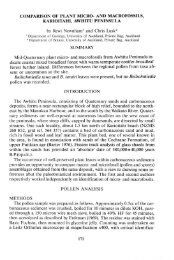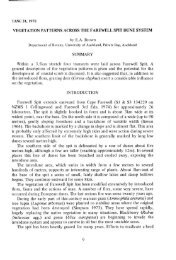aspects of fish biology form and function
aspects of fish biology form and function
aspects of fish biology form and function
You also want an ePaper? Increase the reach of your titles
YUMPU automatically turns print PDFs into web optimized ePapers that Google loves.
298a<br />
georgianus), or a series <strong>of</strong> finlets on the dorsal <strong>and</strong> ventral surfaces<br />
<strong>of</strong> the caudal peduncle (e.g. the mackerel, Scomber australasicus, <strong>and</strong> the<br />
snoek, Thrysites atun) . Another type <strong>of</strong> fin, the adipose fin, is a<br />
characteristic <strong>of</strong> several groups <strong>of</strong> <strong>fish</strong>es such as the salmon, trout,<br />
graylings <strong>and</strong> lizard<strong>fish</strong> (e.g. Synodus sp.), all members <strong>of</strong> the order<br />
Salmoni<strong>form</strong>es, <strong>and</strong> the cat<strong>fish</strong> (Siluri<strong>form</strong>es). This fin is a small flap<br />
<strong>of</strong> fatty tissue covered with skin <strong>and</strong> without any supporting structures.<br />
The <strong>function</strong> <strong>of</strong> this fin is unknown.<br />
Swinribladder<br />
As pressure increases with depth a <strong>fish</strong> will sink unless it<br />
expends considerable energy swimming to maintain its position in the water<br />
column. Bony <strong>fish</strong> possess a swim bladder which acts as a hydrostatic<br />
organ <strong>and</strong> allows the <strong>fish</strong> to regulate its buoyancy. This is a long<br />
silvery bag found within the body cavity, just below the backbone.<br />
Bouyancy is controlled by the secretion <strong>of</strong> gases, via the bloodstream,<br />
to <strong>and</strong> from the swim bladder <strong>and</strong> this enables the <strong>fish</strong> to remain virtually<br />
weightless at any depth its selects. This ability enables the <strong>fish</strong> to<br />
utilise all its swimming energy in a forward driving force.<br />
The degree <strong>of</strong> development <strong>of</strong> this organ is related to the <strong>fish</strong> 1 s<br />
way <strong>of</strong> life. In bottom dwelling <strong>fish</strong> the swim bladder is absent or<br />
greatly reduced (e.g. the tripterygiids <strong>and</strong> the scorpion<strong>fish</strong>, Scorpaena<br />
cardinalis).. The midwater living oblique-swimming blenny (Forsterygion<br />
sp.C) has to swim continously to maintain its postion or it sinks to the<br />
bottom. Pressure changes with depth are most important for <strong>fish</strong> which<br />
make large vertical migrations in their search for food. These <strong>fish</strong><br />
usually have well developed swim bladders. For example, the king<strong>fish</strong><br />
(Seriola gr<strong>and</strong>is) is able to ascend <strong>and</strong> dive rapidly through 75m <strong>of</strong> water,<br />
the swim bladder is large <strong>and</strong> well developed <strong>and</strong> the skull <strong>and</strong> tissues<br />
are full <strong>of</strong> oil which provides a further aid to buoyancy for deep water<br />
swimming.<br />
The cartilaginous <strong>fish</strong>es, the sharks <strong>and</strong> rays, do not possess a<br />
swim bladder <strong>and</strong> therefore sink rapidly to the bottom as soon as they<br />
stop swimming. The body design <strong>of</strong> the sharks compensates to a certain<br />
extent. The large heterccercal tail <strong>and</strong> horizontally placed pectoral fins<br />
give the body some lift. However the relatively inflexible pectoral fins<br />
are capable <strong>of</strong> movement in the vertical plane only. This means the <strong>fish</strong><br />
must swerve to avoid collisions. In the teleosts the possession <strong>of</strong> a










